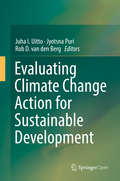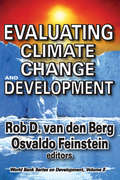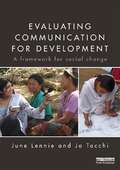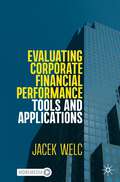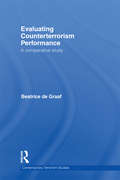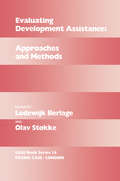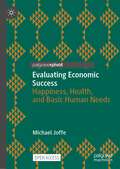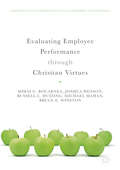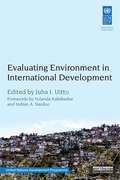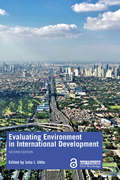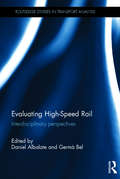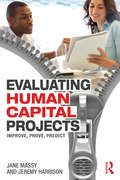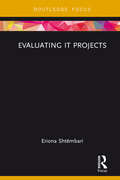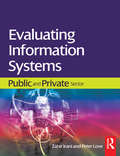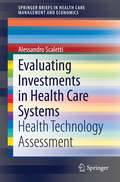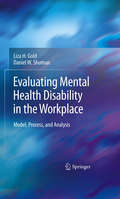- Table View
- List View
Evaluating Adam Smith (Routledge Studies in the History of Economics)
by William HendersonAdam Smith is well recognized as the forefather of modern economics, but his success can be attributed not only to what he wrote but also to his use of language. In this exciting new book, Willie Henderson shows how Smith engaged creatively in writing about the economy, and analyzes the extent to which he tried to ensure that the reader is drawn into the text and informed by it. Demonstrating analysis methods that are helpful to new researchers on Smith’s works, Evaluating Adam Smith sets his work in the cultural context of the eighteenth century and explores the lexical and conceptual inter-relations between Smith and the sources he consulted. Issues explored include Smith’s use of irony and his work in the context of wealth, virtue and happiness as presented in the Moral Sentiments and the Wealth of Nations. Henderson’s informative study employs the literary techniques of close reading and close textual analysis and applies them to sustained passages of Smith’s writing.
Evaluating Adjacency Moves: Balancing Desire with Data
by Chris ZookThe companies best able to pursue growth opportunities are equally aware of the need to impose rules and structure on their own decision-making process, advocating a decision process that pays particular attention to leadership economics and market control in new adjacencies, a robust profit pool, and a clear sense of relatedness to a strong core. This chapter looks at 24 companies to identify and compare some of the most critical criteria to be considered in any first-rate decision process regarding growth investments.
Evaluating Climate Change Action for Sustainable Development
by Juha I. Uitto Jyotsna Puri Rob D. van den BergThis book is open access under a Creative Commons license. This authoritative book presents the ever progressing state of the art in evaluating climate change strategies and action. It builds upon a selection of relevant and practical papers and presentations given at the 2nd International Conference on Evaluating Climate Change and Development held in Washington DC in 2014 and includes perspectives from independent evaluations of the major international organisations supporting climate action in developing countries, such as the Global Environment Facility. The first section of the book sets the stage and provides an overview of independent evaluations, carried out by multilateral development banks and development organisations. Important topics include how policies and organisations aim to achieve impact and how this is measured, whether climate change is mainstreamed into other development programs, and whether operations are meeting the urgency of climate change challenges. The following sections focus on evaluation of climate change projects and policies as they link to development, from the perspective of international organisations, NGO's, multilateral and bilateral aid agencies, and academia. The authors share methodologies or approaches used to better understand problems and assess interventions, strategies and policies. They also share challenges encountered, what was done to solve these and lessons learned from evaluations. Collectively, the authors illustrate the importance of evaluation in providing evidence to guide policy change to informed decision-making.
Evaluating Climate Change and Development: Volume 9, World Bank Series on Development (World Bank Series On Evaluation And Development Ser. #Vol. 8)
by Osvaldo N. FeinsteinClimate change has become one of the most important global issues of our time, with far-reaching natural, socio-economic, and political effects. To address climate change and development issues from the perspective of evaluation, an international conference was held in Alexandria, Egypt. This book distills the essence of that timely conference, building on the experiences of more than 400 reports and studies presented.Developing countries may be particularly vulnerable to the expected onslaught of higher temperatures, rising sea levels, changing waterfall patterns, and increasing natural disasters. All societies will have to reduce their vulnerability to these changes, and this book describes how vulnerabilities may be addressed in a systematic manner so that governments and local communities may better understand what is happening. Different approaches are also discussed, including the use of human security as a criterion for evaluation as well as ways to deal with risk and uncertainty. Evaluating Climate Change and Development presents a rich variety of methods to assess adaptation through monitoring and evaluation.The volume deals with climate change, development, and evaluation; challenges and lessons learned from evaluations; mitigation of climate change; adaptation to climate change; vulnerability, risks and climate change; and presents a concluding chapter on the road ahead. Collectively the authors offer a set of approaches and techniques for the monitoring and evaluation of climate change.
Evaluating Communication for Development: A Framework for Social Change
by June Lennie Jo TacchiEvaluating Communication for Development presents a comprehensive framework for evaluating communication for development (C4D). This framework combines the latest thinking from a number of fields in new ways. It critiques dominant instrumental, accountability-based approaches to development and evaluation and offers an alternative holistic, participatory, mixed methods approach based on systems and complexity thinking and other key concepts. It maintains a focus on power, gender and other differences and social norms. The authors have designed the framework as a way to focus on achieving sustainable social change and to continually improve and develop C4D initiatives. The benefits and rigour of this approach are supported by examples and case studies from a number of action research and evaluation capacity development projects undertaken by the authors over the past fifteen years. Building on current arguments within the fields of C4D and development, the authors reinforce the case for effective communication being a central and vital component of participatory forms of development, something that needs to be appreciated by decision makers. They also consider ways of increasing the effectiveness of evaluation capacity development from grassroots to management level in the development context, an issue of growing importance to improving the quality, effectiveness and utilisation of monitoring and evaluation studies in this field. The book includes a critical review of the key approaches, methodologies and methods that are considered effective for planning evaluation, assessing the outcomes of C4D, and engaging in continuous learning. This rigorous book is of immense theoretical and practical value to students, scholars, and professionals researching or working in development, communication and media, applied anthropology, and evaluation and program planning.
Evaluating Corporate Financial Performance: Tools and Applications
by Jacek WelcThis textbook offers a step-by-step guide through comprehensive financial statement analysis with real-life case studies for students of financial accounting, financial reporting, and financial statement analysis. Structured into five comprehensive sections, it begins by explaining the content of accounting reports themselves and the three primary financial statements (income statement, balance sheet and cash flow statement). It deciphers the notes to financial statements and demonstrates some classical tools such as ratio analysis and multivariable credit risk models that are useful in a retrospective financial statement analysis. It includes simple step-by-step procedures of a prospective (i.e. future-oriented) financial statement simulation and closes with a comprehensive real-life case study that demonstrates a practical application of the analytical tools discussed earlier in the text. Additionally, the textbook includes online appendices consisting of additional comprehensive real-life case studies (of varying degrees of complexity and dealing with different aspects of a practical financial statement analysis), a set of MS Excel files that contain all major calculations included in tables and charts that appear in the core textbook, and a set of webinars in which the most fundamental parts of the core textbook are discussed in the form of the recorded lectures.
Evaluating Counterterrorism Performance: A Comparative Study (Contemporary Terrorism Studies)
by Beatrice de GraafThis book offers a new model for measuring the success and impact of counterterrorism strategies, using four comparative historical case studies. The effectiveness of counterterrorism measures is hard to assess, especially since the social impact of terrorist attacks is a fundamental and complex issue. This book focuses on the impact of counterterrorist measures by introducing the concept of the performative power of counterterrorism: the extent to which governments mobilize public and political support - thereby sometimes even unwittingly assisting terrorists in creating social drama. The concept is applied to counterterrorism in the Netherlands, Italy, the Federal Republic of Germany and the United States in the 1970s. Based on in-depth case study research using new primary sources and interviews with counterterrorist officials and radicals, a correlation is established between a low level of performative power and a decline of terrorist incidents. This is explored in terms of the link between social drama (as enhanced by counterterrorist measures) and ongoing radicalization processes. This book demonstrates that an increase in visible and intrusive counterterrorist measures does not automatically lead to a more effective form of counterterrorism. In the open democracies of the west, not transforming counterterrorism into a performance of power and repression is at least as important as counterterrorism measures themselves. This book will be of much interest to students of terrorism and counter-terrorism, discourse analysis, media and communication studies, conflict studies and IR/Security Studies in general.
Evaluating Development Assistance: Approaches and Methods (Routledge Research EADI Studies in Development #No. 14)
by Olav Stokke Lodewijk BerlageFirst published in 1992. Routledge is an imprint of Taylor & Francis, an informa company.
Evaluating Economic Success: Happiness, Health, and Basic Human Needs (Wellbeing in Politics and Policy)
by Michael JoffeThis open access book argues that a new policy approach is required in order to tackle the numerous problems the world is currently facing. The priority should be on achieving better outcomes for people, especially those facing deprivation or precariousness, by meeting their basic needs. In order to achieve this, the book develops a monitoring system that can act as an objective, an incentive, and a criterion of success for policy makers at all levels of government and in civil society, as well as providing information to guide specific actions. In doing so, the book aims to promote good health and positive social functioning by providing a new approach to help assess how well basic human needs are being met. This involves monitoring the outcomes of the economy that ought to satisfy these needs. It will appeal to all those interested in public policy, official statistics and monitoring, public health and wellbeing, as well as practitioners.
Evaluating Employee Performance through Christian Virtues (Christian Faith Perspectives In Leadership And Business Ser.)
by Bruce E. Winston Mihai C. Bocarnea Joshua Henson Russell L. Huizing Michael MahanIn this book the authors create a statistically validated scale measuring the display of each of the nine fruit of the spirit in employees. The authors will discuss how biblical values are applicable to contemporary organizational leadership and management. These nine virtues span a wide breadth of important personal and organizational attributes including benevolence, affection, gladness, relational harmony, tranquility, perseverance, helpfulness, caring for the welfare of others, adherence to the beliefs and value of others, power used soberly, and mastering one’s desires. While diverse in nature, the list also suggests a holistic development of personal and organizational character. Understanding the manner in which these traits can be measured will be a significant benefit to HRM and HRD scholars conducting research in Christian servant leadership.
Evaluating Environment in International Development
by Juha I. Uitto Yolanda Kakabadse Indran A. NaidooMore than twenty years after the Earth Summit was held in Rio de Janeiro in 1992, both national and international actors in governmental and nongovernmental fields are still searching for insights into how sustainable development can be advanced and environmental concerns incorporated into the development agenda more effectively. Moreover, climate change has emerged as a preeminent challenge to both the environment and to development. Evaluating Environment in International Development provides international perspectives and in-depth knowledge of evaluating development and the environment and applies evaluation knowledge to climate change mitigation and adaptation. The book focuses on the approaches and experiences of leading international organizations, not-for-profits, and multilateral and bilateral aid agencies to illustrate how systematic evaluation is an essential tool for providing evidence for decision-makers. It provides novel and in-depth perspectives on evaluating environment and sustainability issues in developing countries. Moving beyond projects and programmes, it considers aspects such as evaluating normative work on the environment and evaluating environmental consequences of economic and social development efforts. This original collection should be of interest to scholars of environment studies, development studies, international relations, sustainable development and evaluation, as well as practitioners in international organizations and development and environmental NGOs.
Evaluating Environment in International Development
by Juha I. UittoThis book provides novel and in-depth perspectives on evaluating environment and sustainability issues in developing countries. Evaluating Environment in International Development focuses on the approaches and experiences of leading international organizations, not-for-profits, and multilateral and bilateral aid agencies to illustrate how systematic evaluation is an essential tool for providing evidence for decision-makers. Moving beyond projects and programmes, it explores normative work on the environment as well as environmental consequences of economic and social development efforts. This new edition reflects on the 2030 Agenda for Sustainable Development and Sustainable Development Goals and considers how they have influenced efforts in a wide range of countries and what the implications are for evaluation. It also explores ways in which Big Data and geospatial approaches might be utilized. Significantly updated throughout to reflect recent developments in climate change research, and on the implications of the 2020 pandemic, this volume will be of great interest to students and scholars of environment studies, development studies, international relations, sustainable development and evaluation, as well as practitioners in international organizations and development and environmental NGOs.
Evaluating High-Speed Rail: Interdisciplinary perspectives (Routledge Studies in Transport Analysis)
by Daniel Albalate Germà BelHigh-speed Rail (HSR) is a technological transportation advance that has raised the interest of policy makers and researchers worldwide. The study of High-speed Rail is a recent phenomenon but has received increasing attention due to the extension of this mode of transportation around the globe. Evaluating High-Speed Rail contains some of the most recent and cutting edge studies on HSR from different disciplines. The book is organized around a variety of key topics related to the evaluation of High Speed Rail projects and experiences. These topics include: the economic appraisal and evaluation of High-Speed Rail projects; the evaluation of indirect and direct effects of High-Speed Rail; its territorial, redistributive and environmental impacts; its contribution or limitation to urban growth; and the management of challenges created by the arrival of High-Speed Rail lines to core cities. It also covers the contribution of High-Speed Rail to tourism and its impact on intermodal competition, with especial consideration to air transportation. Chapters analyse the expected effects of introducing on-track competition and designing public-private contracts to develop new lines. This cutting-edge volume offers rigorous analysis from top researchers in the field with a clear intention to deliver policy implications and provide the latest analysis on the impact of High Speed Rail. This book is suitable for students and academics interested in transportation infrastructure, economic impacts of public investments, mobility, planning and urban affairs, as well as researchers and policy makers in the transportation and infrastructure sector.
Evaluating Historical CGER Assessments: How Well Have They Predicted Subsequent Exchange Rate Movements?
by Abdul Abiad Prakash Kannan Jungjin LeeA report from the International Monetary Fund.
Evaluating Human Capital Projects: Improve, Prove, Predict
by Jeremy Harrison Jane MassyHow can we be sure that all those projects, programmes and activities that depend for their quality, efficiency and effectiveness on people’s performance have met their objectives? How can we improve the ways in which these projects, programmes and activities are planned so that realistic and useful measurement of their outcomes and value for money becomes possible? How can we produce from these evaluations data of the quality and a standard required to drive future improvement? Evaluating Human Capital Projects addresses these issues for professionals in the private, the public and the not-for-profit sectors. It shows them how to plan and track their investments with the professionalism and discipline widely applied to other capital investments. It is also written as a sourcebook for both professional and Masters-level students in business, health and a wide range of socio-economic disciplines. It addresses effective planning, stakeholder engagement, result-tracking, the identification and removal of barriers to good performance. It provides ideas, theoretical background, extensive references to practice and analysis from the authors’ extensive experience or planning, collection of data, analysis of data and attribution, and reporting to drive future improvement. It is intended to raise the bar on the professionalism with which human capital investments are planned and measured.
Evaluating IT Projects (Routledge Focus on Business and Management)
by Eriona ShtëmbariProject management disciplines have been a part of IT for many years. Why then, are so many challenges still directly associated with how a project is managed? Many projects fail for a myriad of reasons; most, however, stem from poor or inadequate project evaluation and performance appraisal, while, improved project planning and direction is considered to be one of the key factors to IT project success. Eriona Shtembari arranges evaluation methods and techniques into three groups, managerial-financial-and-development. This book explores the process of project evaluation and the purposes of evaluation, given its strong relationship to the success of the project. It examines IT project evaluation; identifies methods and techniques to be used throughout the project life cycle; examines the benefits of project evaluation and proposes a systematic approach/framework of project evaluation to serve as a tool for successful project management. <P><P>Shtembari analyses the most up-to-date research relating to the process and methods/techniques of project evaluation, throughout the project life cycle. From the systematic literature review, she identifies the most usable methods and techniques in project evaluation and focuses on the adequacy of these methods and techniques in the service sector. The theoretical underpinning of the book, serves as a base to interpret the interviews in the case study and build a theory as to how the project evaluation context relates to the proposed scientific theory. The findings in this book provide solutions for practitioners to help them boost the evaluation framework and consequently improve their IT project management.
Evaluating Information Systems: Public And Private Sector
by Peter Love Zahir IraniThe adoption of Information Technology (IT) and Information Systems (IS) represents significant financial investments, with alternative perspectives to the evaluation domain coming from both the public and private sectors.As a result of increasing IT/IS budgets and their growing significance within the development of an organizational infrastructure, the evaluation and performance measurement of new technology remains a perennial issue for management. This book offers a refreshing and updated insight into the social fabric and technical dimensions of IT/IS evaluation together with insights into approaches used to measure the impact of information systems on its stakeholders. In doing so, it describes the portfolio of appraisal techniques that support the justification of IT/IS investments. Evaluating Information Systems explores the concept of evaluation as an evolutionary and dynamic process that takes into account the ability of enterprise technologies to integrate information systems within and between organisations. In particular, when set against a backdrop of organisational learning. It examines the changing portfolio of benefits, costs and risks associated with the adoption and diffusion of technology in today's global marketplace. Finally approaches to impact assessment through performance management and benchmarking is discussed.
Evaluating Investments in Health Care Systems
by Alessandro ScalettiThis book focuses on the innovative and more critical management approach adopted in the PA (Public Administration) in order to identify and describe the main models and instruments to economically evaluate the decision making process in accordance to the specific conditions such as efficiency, effectiveness, cost and equity. The manuscript pays special attention to this sector by identifying, investigating and applying the main evaluation models (logic and methods) of the decision making process, in particular in terms of investment decisions. In the recent decades, with reference to PA, several managerial approaches have been developed from a business management perspective. These managerial approaches differ in terms of variables analyzed, such as the role of governance or the specific logics and mechanisms applied, but all of them have a common goal, which is the improvement of efficiency, effectiveness, economic and equitable decision making and operations in the PA. This book investigates the different mentioned frameworks adopting a wider and integrated analysis perspective on the evaluation of investments in the health care system.
Evaluating M&A Deals--Announcement Effects, Risk Arbitrage and Event Risk
by Carliss Y. BaldwinThe announcement of merger or acquisition conveys new information to the capital markets. This note describes how the stock prices of a Buyer and Target behave after the announcement of a deal. First, for an all-stock deal that is certain to go through, the note defines accouchement effects and describes the fundamental arbitrage relationship between Target and Buyer stock prices. It shows how post-announcement prices may be used to infer the market's estimate of synergies. It then explains how the betas of the two companies change post-announcement and the arbitrage relationship between prices in a cash-and-stock deal. Finally, it defines event risk and explains how it affects the prices of the Buyer and the Target.
Evaluating M&A Deals: Accretion vs. Dilution of Earnings-per-share
by Carliss Y. BaldwinWhen discussing the pros and cons of an acquisition, practitioners often talk about the impact of the deal on the buyer's earnings-per-share (eps). An acquisition is said to be "accretive" if the buyer's eps goes up post-deal; it is "dilutive" if the buyer's eps goes down. Describes why managers are concerned with accretion and dilution; how to tell if a deal is accretive; why high P-E buyers can pay a premium and still have an accretive deal; how accretive deals can be bad (and dilutive deals good); and how much accretion or dilution to expect based on the terms of a deal.
Evaluating M&A Deals: Floors, Caps, and Collars
by Carliss Y. BaldwinAs equity consideration has become more popular in acquisitions, so has the use of the "pricing-protection" mechanisms, such as floors, caps and collars. These contractual devices provide insurance to the shareholders of the target, and may protect the buyer as well. The purpose of this note is to define the main categories of price protection, and explain their impact on the payoffs and value of the deal to the target's shareholders.
Evaluating M&A Deals: How Poison Pills Work
by Carliss Y. BaldwinThe poison pill defense against hostile takeovers was invented in 1982 by Martin Lipton, of Wachtell, Lipton, Rosen and Katz. Pills are considered the most effective of all the normal defenses against a hostile bidder. Describes the two basic types of poison pills (flip-ins and flip-overs), and explains how the form of a tender offer changes the impact of a pill on the bidder. Also describes how bidders can set up tender offers to avoid poison pills.
Evaluating Mental Health Disability in the Workplace
by Liza H. Gold Daniel W. ShumanAs many as one in four adults in the workforce will suffer from psychiatric illness in a given year. Such illness can have serious consequences -- job loss, lawsuits, workplace violence--yet the effects of mental health issues on job functioning are rarely covered in clinical training. In addition, clinicians are often asked to provide opinions on an employee's fitness for work or an evaluation for disability benefits, only to find themselves embroiled in complex legal and administrative conflicts. A unique collaboration between a renowned clinical professor of psychiatry and a noted legal expert, Evaluating Mental Health Disability in the Workplace approaches the topic from two distinct areas: the legal context and issues relevant to disability and disability-related evaluations, and the interplay of factors in the relationship between work and psychiatric illness. From this dual perspective, the authors advocate for higher professional standards ensuring that employers, evaluees, or third parties are provided with the most reliable information. Key features of the book: A robust assessment model of psychological disability in the workplace Practice guidelines for conducting workplace mental health disability evaluations Legal and ethical aspects of employment evaluations, especially as they differ from clinical procedure Examination of the process of psychiatric disability development Issues specific to evaluations for Social Security, Workers' Compensation, and other disability benefit programs Review of relevant administrative and case law. As an introduction to these complex issues or for the further improvement of evaluation skills, Evaluating Mental Health Disability in the Workplace is a timely reference for psychiatrists, psychologists, forensic mental health specialists, and attorneys in this field.
Evaluating Microsavings Programs: Green Bank of the Philippines (A)
by Dean Karlan Nava Ashraf Wesley Yin Marc ShotlandGreen Bank of the Philippines was known for its product innovation and its ability to bring new products to market. In 2002, Green Bank designed an untested commitment savings product that both gave individuals access to formal savings and helped them commit to reaching their savings goals. Omar Andaya, the Green Bank president, must decide how to evaluate the success of this product. The management team at Green Bank discusses various evaluation methods, including a formal quantitative impact evaluation using a randomized control trial (RCT), and the value an impact assessment brings to the Bank. In particular, they grapple with the question of how success is measured for a product both for the bank and for its clients. The case highlights the issues an organization must consider before deciding to do an impact assessment as well as common design challenges.
Evaluating Microsavings Programs: Green Bank of the Philippines (A)
by Dean Karlan Nava Ashraf Wesley Yin Marc ShotlandGreen Bank of the Philippines was known for its product innovation and its ability to bring new products to market. In 2002, Green Bank designed an untested commitment savings product that both gave individuals access to formal savings and helped them commit to reaching their savings goals. Omar Andaya, the Green Bank president, must decide how to evaluate the success of this product. The management team at Green Bank discusses various evaluation methods, including a formal quantitative impact evaluation using a randomized control trial (RCT), and the value an impact assessment brings to the Bank. In particular, they grapple with the question of how success is measured for a product both for the bank and for its clients. The case highlights the issues an organization must consider before deciding to do an impact assessment as well as common design challenges.


